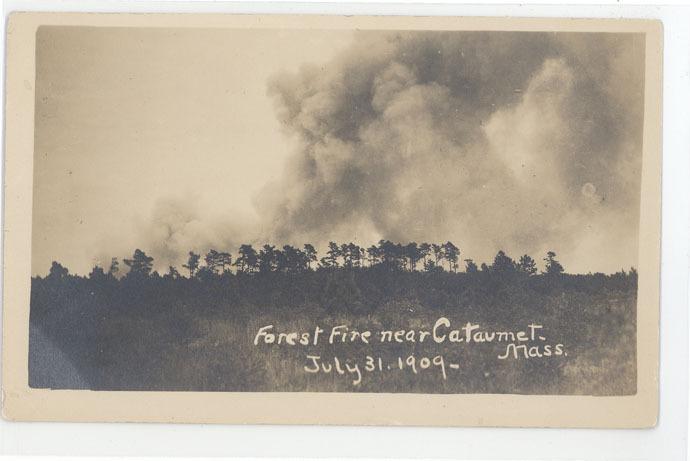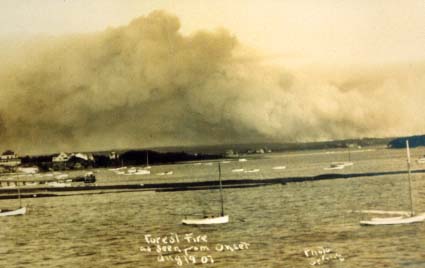|
CapeCodFD.com |
|
|
|
|
|
HISTORY - IN REVIEW |
|
~
THE STORY ~ |
|
|
|
Cape Cod Brush Breaker |
|
PAGE CONTENTS |
M - Map 01 - The Cape Cod Forest Fire Problem 02 - Historical Cape Cod Forest Fires 03 - One Large Cape Cod Forest Fire - 1946 04 - Cape Cod Forest Fire Jumped Route 6 - May 1965 05 - Plymouth County Forest Fires 06 - Some More Recent Forest Fires 07 - The Fire Danger - Firefighter Memorial 08 - Fire Prevention - Only You! 09 - Public Education - Smokey Bear 10 - Spotting Fires - Fire Towers 11 - Spotting Fires - Fire Patrol Planes 12 - Locating Fires - Fire Patrol Trucks 13 - Early Firefighting - By Hand 14 - Early Fire Apparatus 15 - First Brush Breakers 16 - Barnstable County Brush Breakers 17 - State Forest Fire Trucks 18 - On The Islands - Brush Trucks 19 - Plymouth County - Brush Trucks 20 - Brush Breakers Working 21 - The Hey Day of Brush Breakers 22 - Tankers and Other Support Apparatus 23 - Forest Fire Training 24 - Small, Medium, and Large Brush Trucks 25 - The Newest Brush Trucks 26 - The END TIMES |
|
MAP |
|
CAPE COD & THE ISLANDS
|
BARNSTABLE COUNTY
|
| 1 - THE CAPE
COD FOREST FIRE PROBLEM
|
|
Forest fires raging through pine forest. |
Cape Cod and other areas of Southeastern Massachusetts are known for the many serious brush and forest fires that struck communities over the years. |

In 1780, an early morning lightning storm started a fire in
the woods. Clouds of dark smoke filled the sky to the west of Sandwich in what
was called "The Dark Day." It had been for generations, the practice
to "fire the woods" each year as the Indians had done, usually in April, to burn
off the grass and
In 1887, a huge forest fire burned over 25,000 acres from the Pocasset
section of Bourne to Sandwich. This fire destroyed approximately 600
cord of stacked wood at the Sandwich Glass Company as well as several
stands of oak and pine ready for cutting. The Glass company was forced
to then purchase and burn coal in its furnaces at a substantial financial
cost. This, along with a labor union strike, ultimately contributed to the On May 30,1923 a fire began in the woods in Pocasset village. By the end of the day, it was thought that the fire was out. By morning however, it picked up again, burning through the day. Once again, it was believed that it was under control by nightfall, only to flare up again and again for 7 days. An area of approximately 25,000 acres, between Pocasset village, Sagamore, Sandwich, East Sandwich, and South Sandwich was left blackened. The State Commissioner of Conservation stated that "something was radically wrong" adding that the fire could have been contained to about 1,000 acres if it had been properly handled since it was not even a "fire day." Following this fire, the state purchased hundreds of acres of burned over forest in Bourne and Sandwich and created the Shawme State Forest in 1923. The name was changed in 1938 to the Shawme-Crowell State Forest, honoring Lincoln Crowell for his long dedication to the Cape's forests. Crowell was killed in 1938 when the patrol truck he was in was struck by a train in Brewster.
"A concerted national fire prevention program (dealing with wildland fires) did
not follow,
until two experiments in 1928.... The Cape Cod Forest Fire Prevention experiment
and the Forest fires can be extremely dangerous, especially when fought by hand. One of the worst fires ever on Cape Cod struck on April 27, 1938. A number of fires were burning on the Cape and in Plymouth County, when another fire began in Sandwich Bourne Deputy Chief Gibbs took a crew of young men, volunteers, with him in to fight the fire west of what is now Route 130 in Sandwich. 40 mile per hour winds fanned the flames and the men were soon trapped by the fire. All received serious burns. Three men, Thomas Adams, age 43; Gordon King, age 34, and Ervin Draber, age 28 died that day fighting this forest fire. A memorial stands today near the site where they died.
1780 - THE DARK DAY
1887 - 25,000 ACRES
1923 - 25,000 ACRES
1923 - STATE FOREST CREATED
1928 - CAPE COD FOREST FIRE PREVENTION
APRIL 27, 1938 - 3 FIREFIGHTERS KILLED
|
| 2 - HISTORIC
CAPE COD FOREST FIRES
|
|
Historic forest fires raged across Cape Cod many times. |
Going far back in history, large forest fires have impacted communities and industries. |
|
| 3 - ONE
LARGE CAPE COD FOREST FIRE - 1946 |
|
The 1946 Forest Fire burned about 15,000 acres |
A 1946 Forest Fire in the upper Cape burned for days. It covered about 15,000 acres. A documentary film was made showing the progress and response to the fire including the use of brush breakers of that time. |
| 4 - CAPE COD
FOREST FIRE JUMPED ROUTE 6 - MAY 1965 |
|
1965 Fire jumped Route 6 in Sandwich |
A rapidly moving forest fire that started in the Otis/Camp Edwards Military Reservation raged to and jumped over the Mid-Cape Highway (Route 6) in Sandwich on May 1, 1965. It scorched and blackened many acres of forest visible for a number of years. |
| 5 - PLYMOUTH
COUNTY FOREST FIRES
|
|
Map showing some of the historic Plymouth County Forest Fires. |
There is a map inside the Myles Standish State Forest District 2 Headquarters showing some of the many significant fires that have struck Plymouth County over the years. |
| 6 - SOME
MORE RECENT FOREST FIRES |
|
The PAVE PAWS Forest Fire burned in the 1988. |
A large fire known as the PAVE PAWS Fire occurred on April 22, 1988. It burned about 1600 acres around the radar site. Photo taken from Fire Patrol Plane P18. |
| 7 - THE FIRE
DANGER - FIREFIGHTER MEMORIAL |
|
Firefighter Memorial Route 130 in Sandwich |
A forest fire on April 27, 1938 burned out of the Camp Edwards National Guard Camp, eventually covering a 5 mile wide by 12 mile long area toward Sandwich into what would be the Shawme Crowell State Forest. Three of the firemen who battled the blaze were trapped, burned, and killed by the fire. The memorial remembers Thomas Adams, Ervin Draber, and Gordon King who were lost that day. |
| 8 - FIRE
PREVENTION - ONLY YOU! |
|
The prevention of forest fires became a major effort. |
"Only you can prevent forest fires." |
| 9 - PUBLIC
EDUCATION - SMOKEY BEAR |
|
Smokey Bear |
Public education and fire prevention go hand in hand. |
| 10 -
SPOTTING FIRES - FIRE TOWERS
|
|
Fire towers, like this one in Barnstable in 1919, were staffed by
spotters who |
Fire towers became a vital part of combating forest fires. The earlier the fire could be detected and reported, the sooner it could be contained. |
| 11 -
SPOTTING FIRES - FIRE PATROL PLANES
|
|
Barnstable County Fire Patrol Plane P-18 |
Barnstable County and Plymouth County both operated Fire Patrol Planes for many years. Going back to at least 1954, and perhaps before, these planes could provide assistance in locating fires and advising chiefs and personnel on the ground how to safely access them. |
| 12 -
LOCATING FIRES - FIRE PATROL TRUCKS |
|
Fire Patrol Trucks were also a vital aspect of battling wild fires. |
Before many fire departments were staffed, there were staffed Fire Patrol trucks that would be in contact via radio with fire towers and the fire patrol plane and often reached fires first. Shown here around 1958 at the Marstons Mills Airport are the Town of Barnstable Patrol truck 210 and the State Patrol Truck Car 3, as well as some chiefs. |
| 13 - EARLY
FIREFIGHTING - BY HAND |
|
In the beginning, fires were fought by hand |
Many of the largest fires were fought before there were many motorvehicles |
| 14 - EARLY
FIRE APPARATUS |
|
Photo |
| Info |
| 15 - FIRST
BRUSH BREAKERS |
|
Photo |
| Info |
| 16 -
BARNSTABLE COUNTY BRUSH BREAKERS
|
|
Photo |
| Info |
| 17 - STATE -
FOREST FIRE TRUCKS |
|
Photo |
| Info |
| 18 - ON THE
ISLANDS - BRUSH TRUCKS |
|
Photo |
| Info |
| 19 -
PLYMOUTH COUNTY - BRUSH BREAKERS |
|
Photo |
| Info |
| 20 - BRUSH
BREAKERS WORKING |
|
Photo |
| Info |
| 21 - THE HEY
DAYS OF CAPE COD BRUSH BREAKERS |
|
Photo |
| Info |
| 22 - TANKERS
AND OTHER SUPPORT UNITS |
|
Photo |
| Info |
| 23 - FOREST
FIRE TRAINING |
|
Photo |
| Info |
| 24 - SMALL,
MEDIUM, AND LARGE BRUSH TRUCKS |
|
Photo |
| Info |
| 25 - SOME OF
THE NEWEST BRUSH BREAKERS |
|
Photo |
| Info |
| 26 - THE END
TIMES |
|
Photo |
| Info |
|
|



